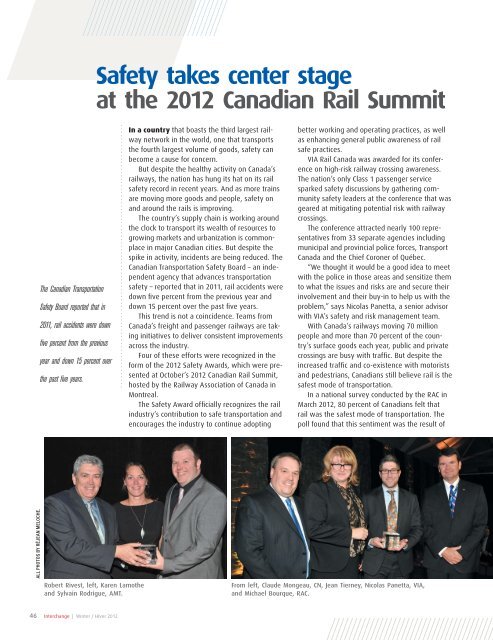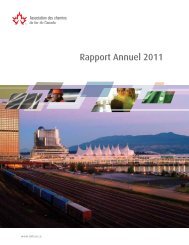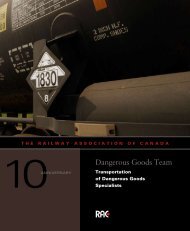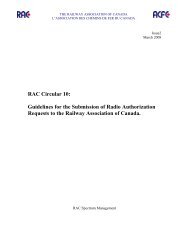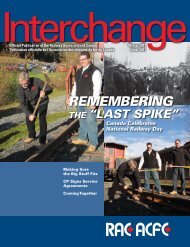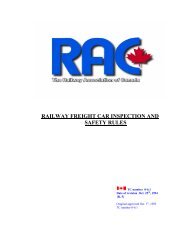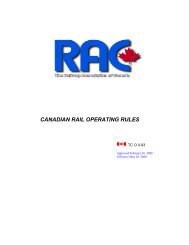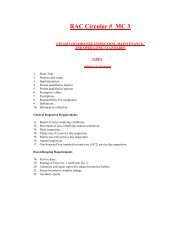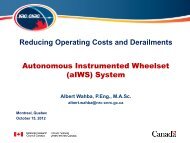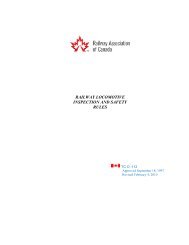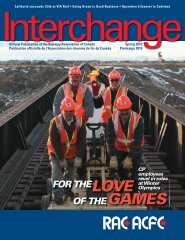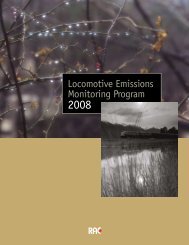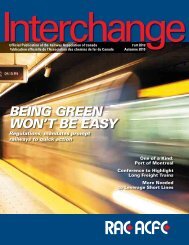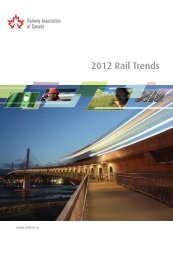pdf 18 mb - Railway Association of Canada
pdf 18 mb - Railway Association of Canada
pdf 18 mb - Railway Association of Canada
- No tags were found...
Create successful ePaper yourself
Turn your PDF publications into a flip-book with our unique Google optimized e-Paper software.
Safety takes center stageat the 2012 Canadian Rail SummitThe Canadian TransportationSafety Board reported that in2011, rail accidents were downfi ve percent from the previousyear and down 15 percent overthe past fi ve years.In a country that boasts the third largest railwaynetwork in the world, one that transportsthe fourth largest volume <strong>of</strong> goods, safety canbecome a cause for concern.But despite the healthy activity on <strong>Canada</strong>’srailways, the nation has hung its hat on its railsafety record in recent years. And as more trainsare moving more goods and people, safety onand around the rails is improving.The country’s supply chain is working aroundthe clock to transport its wealth <strong>of</strong> resources togrowing markets and urbanization is commonplacein major Canadian cities. But despite thespike in activity, incidents are being reduced. TheCanadian Transportation Safety Board – an independentagency that advances transportationsafety – reported that in 2011, rail accidents weredown five percent from the previous year anddown 15 percent over the past five years.This trend is not a coincidence. Teams from<strong>Canada</strong>’s freight and passenger railways are takinginitiatives to deliver consistent improvementsacross the industry.Four <strong>of</strong> these efforts were recognized in theform <strong>of</strong> the 2012 Safety Awards, which were presentedat October’s 2012 Canadian Rail Summit,hosted by the <strong>Railway</strong> <strong>Association</strong> <strong>of</strong> <strong>Canada</strong> inMontreal.The Safety Award <strong>of</strong>ficially recognizes the railindustry’s contribution to safe transportation andencourages the industry to continue adoptingbetter working and operating practices, as wellas enhancing general public awareness <strong>of</strong> railsafe practices.VIA Rail <strong>Canada</strong> was awarded for its conferenceon high-risk railway crossing awareness.The nation’s only Class 1 passenger servicesparked safety discussions by gathering communitysafety leaders at the conference that wasgeared at mitigating potential risk with railwaycrossings.The conference attracted nearly 100 representativesfrom 33 separate agencies includingmunicipal and provincial police forces, Transport<strong>Canada</strong> and the Chief Coroner <strong>of</strong> Québec.“We thought it would be a good idea to meetwith the police in those areas and sensitize themto what the issues and risks are and secure theirinvolvement and their buy-in to help us with theproblem,” says Nicolas Panetta, a senior advisorwith VIA’s safety and risk management team.With <strong>Canada</strong>’s railways moving 70 millionpeople and more than 70 percent <strong>of</strong> the country’ssurface goods each year, public and privatecrossings are busy with traffic. But despite theincreased traffic and co-existence with motoristsand pedestrians, Canadians still believe rail is thesafest mode <strong>of</strong> transportation.In a national survey conducted by the RAC inMarch 2012, 80 percent <strong>of</strong> Canadians felt thatrail was the safest mode <strong>of</strong> transportation. Thepoll found that this sentiment was the result <strong>of</strong>ALL PHOTOS BY RÉJEAN MELOCHE.Robert Rivest, left, Karen Lamotheand Sylvain Rodrigue, AMT.From left, Claude Mongeau, CN, Jean Tierney, Nicolas Panetta, VIA,and Michael Bourque, RAC.46Interchange | Winter / Hiver 2012


